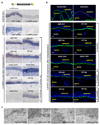Regeneration of the entire human epidermis using transgenic stem cells
- PMID: 29144448
- PMCID: PMC6283270
- DOI: 10.1038/nature24487
Regeneration of the entire human epidermis using transgenic stem cells
Abstract
Junctional epidermolysis bullosa (JEB) is a severe and often lethal genetic disease caused by mutations in genes encoding the basement membrane component laminin-332. Surviving patients with JEB develop chronic wounds to the skin and mucosa, which impair their quality of life and lead to skin cancer. Here we show that autologous transgenic keratinocyte cultures regenerated an entire, fully functional epidermis on a seven-year-old child suffering from a devastating, life-threatening form of JEB. The proviral integration pattern was maintained in vivo and epidermal renewal did not cause any clonal selection. Clonal tracing showed that the human epidermis is sustained not by equipotent progenitors, but by a limited number of long-lived stem cells, detected as holoclones, that can extensively self-renew in vitro and in vivo and produce progenitors that replenish terminally differentiated keratinocytes. This study provides a blueprint that can be applied to other stem cell-mediated combined ex vivo cell and gene therapies.
Conflict of interest statement
Figures




Comment in
-
Skin regeneration with insights.Nature. 2017 Nov 8;551(7679):141. doi: 10.1038/551141a. Nature. 2017. PMID: 29120439 No abstract available.
-
Gene therapy: Transgenic stem cells replace skin.Nature. 2017 Nov 16;551(7680):306-307. doi: 10.1038/nature24753. Epub 2017 Nov 8. Nature. 2017. PMID: 29132145 No abstract available.
-
Stem cells: Regenerating the skin of a young patient.Nat Rev Mol Cell Biol. 2018 Jan;19(1):1. doi: 10.1038/nrm.2017.124. Epub 2017 Nov 29. Nat Rev Mol Cell Biol. 2018. PMID: 29184196 No abstract available.
-
Stem cells: Regenerating the skin of a young patient.Nat Rev Genet. 2018 Jan;19(1):4-5. doi: 10.1038/nrg.2017.106. Epub 2017 Dec 4. Nat Rev Genet. 2018. PMID: 29199284 No abstract available.
-
The Skin(ny) on Regenerating the Largest Organ to Save a Patient's Life.Cell Stem Cell. 2018 Jan 4;22(1):14-15. doi: 10.1016/j.stem.2017.12.005. Cell Stem Cell. 2018. PMID: 29304338 Free PMC article.
-
Change the genes to fix the skin.Nature. 2018 Dec;564(7735):S14-S15. doi: 10.1038/d41586-018-07640-2. Nature. 2018. PMID: 30542189 No abstract available.

